THT3111 - Kakadu National Park: Stakeholder Management & CHM
VerifiedAdded on 2023/06/11
|10
|2889
|188
Case Study
AI Summary
This report analyzes the management plan and sustainability principles of Kakadu National Park, focusing on its natural environment and rich cultural heritage. It examines the gap between the park's demands and the resources available to meet them, leading to environmental and cultural challenges. Secondary data from journals and news articles highlight issues such as ecological imbalance due to climate change and managerial shortcomings in the joint management initiative with aboriginal communities. Despite efforts by authorities and international organizations, unresolved issues persist. The report recommends strategies for the government and park authority to address these problems, improve tourism, and ensure the sustainable preservation of Kakadu National Park.

Running head: ANALYSIS OF KAKADU NATIONAL PARK
ANALYSIS OF KAKADU NATIONAL PARK
name of the student:
name of University:
Author's note:
ANALYSIS OF KAKADU NATIONAL PARK
name of the student:
name of University:
Author's note:
Paraphrase This Document
Need a fresh take? Get an instant paraphrase of this document with our AI Paraphraser
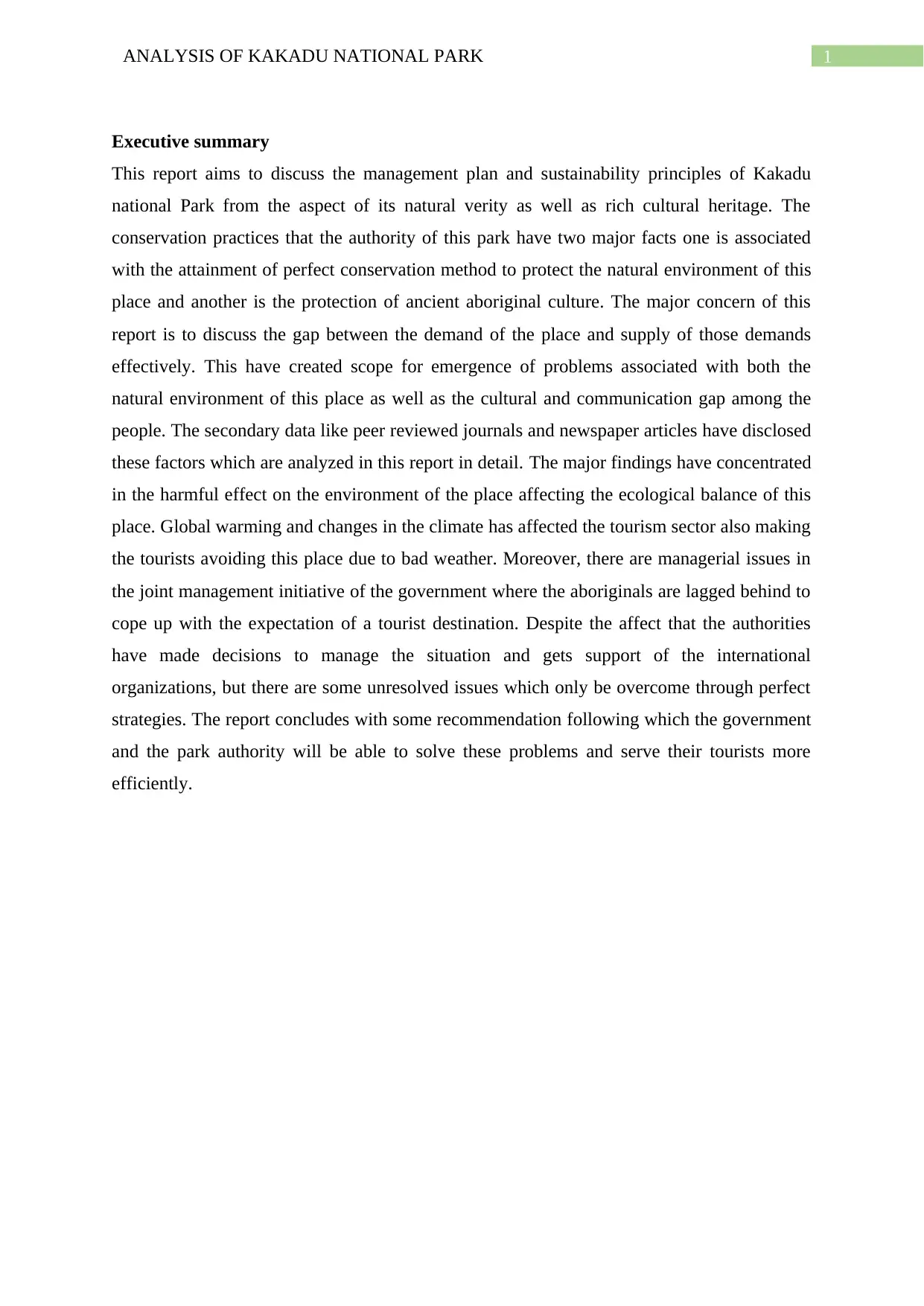
1ANALYSIS OF KAKADU NATIONAL PARK
Executive summary
This report aims to discuss the management plan and sustainability principles of Kakadu
national Park from the aspect of its natural verity as well as rich cultural heritage. The
conservation practices that the authority of this park have two major facts one is associated
with the attainment of perfect conservation method to protect the natural environment of this
place and another is the protection of ancient aboriginal culture. The major concern of this
report is to discuss the gap between the demand of the place and supply of those demands
effectively. This have created scope for emergence of problems associated with both the
natural environment of this place as well as the cultural and communication gap among the
people. The secondary data like peer reviewed journals and newspaper articles have disclosed
these factors which are analyzed in this report in detail. The major findings have concentrated
in the harmful effect on the environment of the place affecting the ecological balance of this
place. Global warming and changes in the climate has affected the tourism sector also making
the tourists avoiding this place due to bad weather. Moreover, there are managerial issues in
the joint management initiative of the government where the aboriginals are lagged behind to
cope up with the expectation of a tourist destination. Despite the affect that the authorities
have made decisions to manage the situation and gets support of the international
organizations, but there are some unresolved issues which only be overcome through perfect
strategies. The report concludes with some recommendation following which the government
and the park authority will be able to solve these problems and serve their tourists more
efficiently.
Executive summary
This report aims to discuss the management plan and sustainability principles of Kakadu
national Park from the aspect of its natural verity as well as rich cultural heritage. The
conservation practices that the authority of this park have two major facts one is associated
with the attainment of perfect conservation method to protect the natural environment of this
place and another is the protection of ancient aboriginal culture. The major concern of this
report is to discuss the gap between the demand of the place and supply of those demands
effectively. This have created scope for emergence of problems associated with both the
natural environment of this place as well as the cultural and communication gap among the
people. The secondary data like peer reviewed journals and newspaper articles have disclosed
these factors which are analyzed in this report in detail. The major findings have concentrated
in the harmful effect on the environment of the place affecting the ecological balance of this
place. Global warming and changes in the climate has affected the tourism sector also making
the tourists avoiding this place due to bad weather. Moreover, there are managerial issues in
the joint management initiative of the government where the aboriginals are lagged behind to
cope up with the expectation of a tourist destination. Despite the affect that the authorities
have made decisions to manage the situation and gets support of the international
organizations, but there are some unresolved issues which only be overcome through perfect
strategies. The report concludes with some recommendation following which the government
and the park authority will be able to solve these problems and serve their tourists more
efficiently.
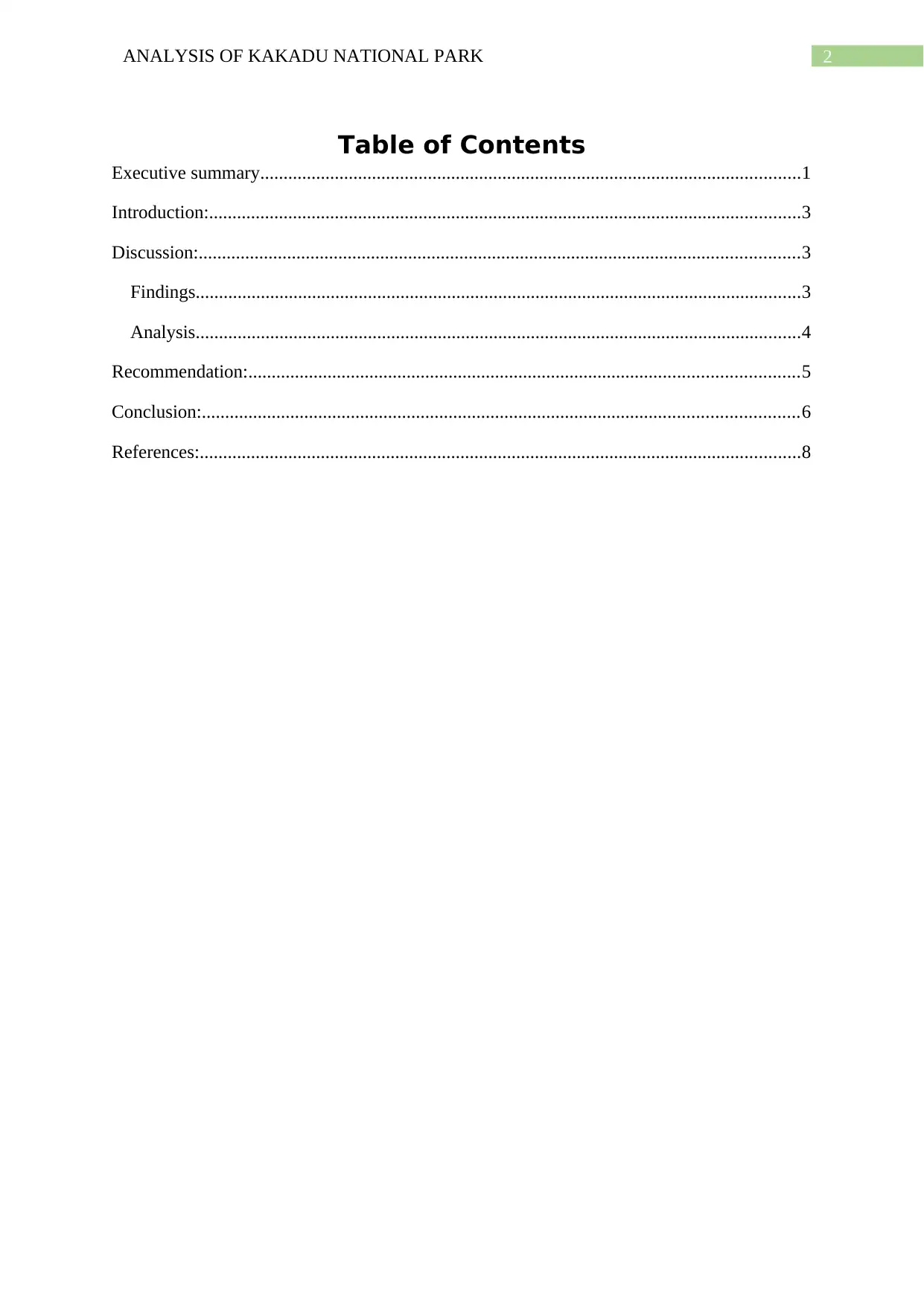
2ANALYSIS OF KAKADU NATIONAL PARK
Table of Contents
Executive summary....................................................................................................................1
Introduction:...............................................................................................................................3
Discussion:.................................................................................................................................3
Findings..................................................................................................................................3
Analysis..................................................................................................................................4
Recommendation:......................................................................................................................5
Conclusion:................................................................................................................................6
References:.................................................................................................................................8
Table of Contents
Executive summary....................................................................................................................1
Introduction:...............................................................................................................................3
Discussion:.................................................................................................................................3
Findings..................................................................................................................................3
Analysis..................................................................................................................................4
Recommendation:......................................................................................................................5
Conclusion:................................................................................................................................6
References:.................................................................................................................................8
⊘ This is a preview!⊘
Do you want full access?
Subscribe today to unlock all pages.

Trusted by 1+ million students worldwide
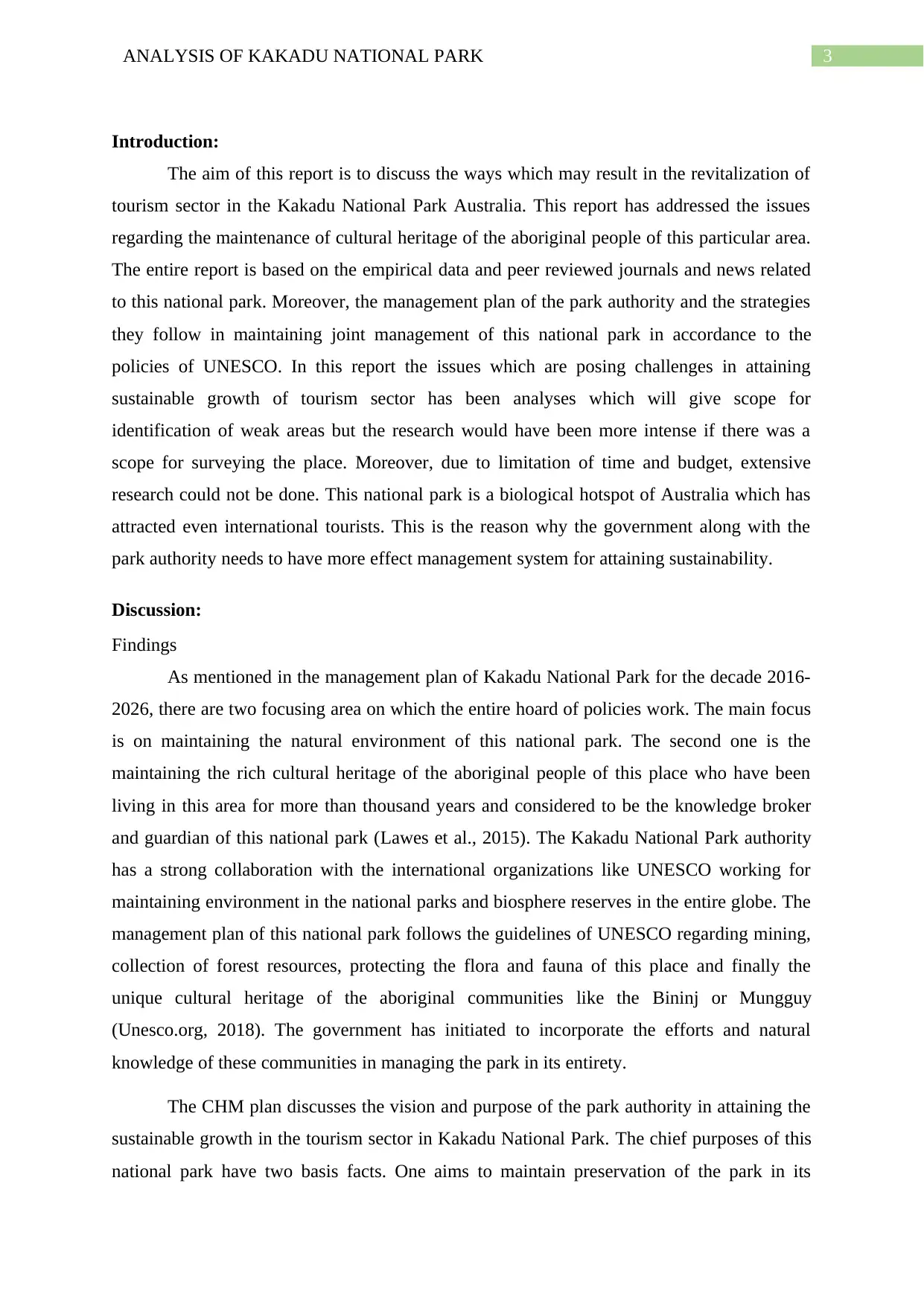
3ANALYSIS OF KAKADU NATIONAL PARK
Introduction:
The aim of this report is to discuss the ways which may result in the revitalization of
tourism sector in the Kakadu National Park Australia. This report has addressed the issues
regarding the maintenance of cultural heritage of the aboriginal people of this particular area.
The entire report is based on the empirical data and peer reviewed journals and news related
to this national park. Moreover, the management plan of the park authority and the strategies
they follow in maintaining joint management of this national park in accordance to the
policies of UNESCO. In this report the issues which are posing challenges in attaining
sustainable growth of tourism sector has been analyses which will give scope for
identification of weak areas but the research would have been more intense if there was a
scope for surveying the place. Moreover, due to limitation of time and budget, extensive
research could not be done. This national park is a biological hotspot of Australia which has
attracted even international tourists. This is the reason why the government along with the
park authority needs to have more effect management system for attaining sustainability.
Discussion:
Findings
As mentioned in the management plan of Kakadu National Park for the decade 2016-
2026, there are two focusing area on which the entire hoard of policies work. The main focus
is on maintaining the natural environment of this national park. The second one is the
maintaining the rich cultural heritage of the aboriginal people of this place who have been
living in this area for more than thousand years and considered to be the knowledge broker
and guardian of this national park (Lawes et al., 2015). The Kakadu National Park authority
has a strong collaboration with the international organizations like UNESCO working for
maintaining environment in the national parks and biosphere reserves in the entire globe. The
management plan of this national park follows the guidelines of UNESCO regarding mining,
collection of forest resources, protecting the flora and fauna of this place and finally the
unique cultural heritage of the aboriginal communities like the Bininj or Mungguy
(Unesco.org, 2018). The government has initiated to incorporate the efforts and natural
knowledge of these communities in managing the park in its entirety.
The CHM plan discusses the vision and purpose of the park authority in attaining the
sustainable growth in the tourism sector in Kakadu National Park. The chief purposes of this
national park have two basis facts. One aims to maintain preservation of the park in its
Introduction:
The aim of this report is to discuss the ways which may result in the revitalization of
tourism sector in the Kakadu National Park Australia. This report has addressed the issues
regarding the maintenance of cultural heritage of the aboriginal people of this particular area.
The entire report is based on the empirical data and peer reviewed journals and news related
to this national park. Moreover, the management plan of the park authority and the strategies
they follow in maintaining joint management of this national park in accordance to the
policies of UNESCO. In this report the issues which are posing challenges in attaining
sustainable growth of tourism sector has been analyses which will give scope for
identification of weak areas but the research would have been more intense if there was a
scope for surveying the place. Moreover, due to limitation of time and budget, extensive
research could not be done. This national park is a biological hotspot of Australia which has
attracted even international tourists. This is the reason why the government along with the
park authority needs to have more effect management system for attaining sustainability.
Discussion:
Findings
As mentioned in the management plan of Kakadu National Park for the decade 2016-
2026, there are two focusing area on which the entire hoard of policies work. The main focus
is on maintaining the natural environment of this national park. The second one is the
maintaining the rich cultural heritage of the aboriginal people of this place who have been
living in this area for more than thousand years and considered to be the knowledge broker
and guardian of this national park (Lawes et al., 2015). The Kakadu National Park authority
has a strong collaboration with the international organizations like UNESCO working for
maintaining environment in the national parks and biosphere reserves in the entire globe. The
management plan of this national park follows the guidelines of UNESCO regarding mining,
collection of forest resources, protecting the flora and fauna of this place and finally the
unique cultural heritage of the aboriginal communities like the Bininj or Mungguy
(Unesco.org, 2018). The government has initiated to incorporate the efforts and natural
knowledge of these communities in managing the park in its entirety.
The CHM plan discusses the vision and purpose of the park authority in attaining the
sustainable growth in the tourism sector in Kakadu National Park. The chief purposes of this
national park have two basis facts. One aims to maintain preservation of the park in its
Paraphrase This Document
Need a fresh take? Get an instant paraphrase of this document with our AI Paraphraser
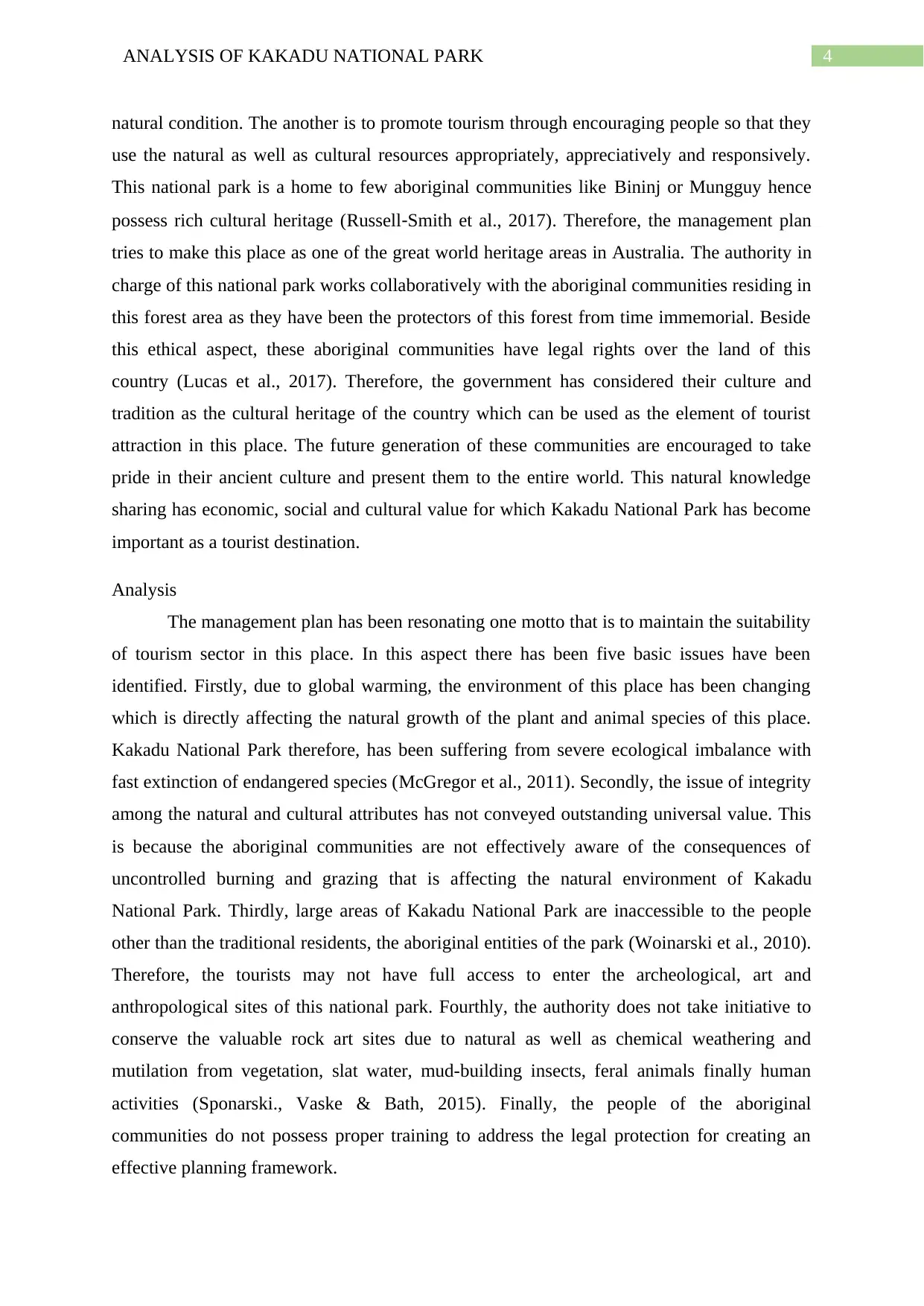
4ANALYSIS OF KAKADU NATIONAL PARK
natural condition. The another is to promote tourism through encouraging people so that they
use the natural as well as cultural resources appropriately, appreciatively and responsively.
This national park is a home to few aboriginal communities like Bininj or Mungguy hence
possess rich cultural heritage (Russell‐Smith et al., 2017). Therefore, the management plan
tries to make this place as one of the great world heritage areas in Australia. The authority in
charge of this national park works collaboratively with the aboriginal communities residing in
this forest area as they have been the protectors of this forest from time immemorial. Beside
this ethical aspect, these aboriginal communities have legal rights over the land of this
country (Lucas et al., 2017). Therefore, the government has considered their culture and
tradition as the cultural heritage of the country which can be used as the element of tourist
attraction in this place. The future generation of these communities are encouraged to take
pride in their ancient culture and present them to the entire world. This natural knowledge
sharing has economic, social and cultural value for which Kakadu National Park has become
important as a tourist destination.
Analysis
The management plan has been resonating one motto that is to maintain the suitability
of tourism sector in this place. In this aspect there has been five basic issues have been
identified. Firstly, due to global warming, the environment of this place has been changing
which is directly affecting the natural growth of the plant and animal species of this place.
Kakadu National Park therefore, has been suffering from severe ecological imbalance with
fast extinction of endangered species (McGregor et al., 2011). Secondly, the issue of integrity
among the natural and cultural attributes has not conveyed outstanding universal value. This
is because the aboriginal communities are not effectively aware of the consequences of
uncontrolled burning and grazing that is affecting the natural environment of Kakadu
National Park. Thirdly, large areas of Kakadu National Park are inaccessible to the people
other than the traditional residents, the aboriginal entities of the park (Woinarski et al., 2010).
Therefore, the tourists may not have full access to enter the archeological, art and
anthropological sites of this national park. Fourthly, the authority does not take initiative to
conserve the valuable rock art sites due to natural as well as chemical weathering and
mutilation from vegetation, slat water, mud-building insects, feral animals finally human
activities (Sponarski., Vaske & Bath, 2015). Finally, the people of the aboriginal
communities do not possess proper training to address the legal protection for creating an
effective planning framework.
natural condition. The another is to promote tourism through encouraging people so that they
use the natural as well as cultural resources appropriately, appreciatively and responsively.
This national park is a home to few aboriginal communities like Bininj or Mungguy hence
possess rich cultural heritage (Russell‐Smith et al., 2017). Therefore, the management plan
tries to make this place as one of the great world heritage areas in Australia. The authority in
charge of this national park works collaboratively with the aboriginal communities residing in
this forest area as they have been the protectors of this forest from time immemorial. Beside
this ethical aspect, these aboriginal communities have legal rights over the land of this
country (Lucas et al., 2017). Therefore, the government has considered their culture and
tradition as the cultural heritage of the country which can be used as the element of tourist
attraction in this place. The future generation of these communities are encouraged to take
pride in their ancient culture and present them to the entire world. This natural knowledge
sharing has economic, social and cultural value for which Kakadu National Park has become
important as a tourist destination.
Analysis
The management plan has been resonating one motto that is to maintain the suitability
of tourism sector in this place. In this aspect there has been five basic issues have been
identified. Firstly, due to global warming, the environment of this place has been changing
which is directly affecting the natural growth of the plant and animal species of this place.
Kakadu National Park therefore, has been suffering from severe ecological imbalance with
fast extinction of endangered species (McGregor et al., 2011). Secondly, the issue of integrity
among the natural and cultural attributes has not conveyed outstanding universal value. This
is because the aboriginal communities are not effectively aware of the consequences of
uncontrolled burning and grazing that is affecting the natural environment of Kakadu
National Park. Thirdly, large areas of Kakadu National Park are inaccessible to the people
other than the traditional residents, the aboriginal entities of the park (Woinarski et al., 2010).
Therefore, the tourists may not have full access to enter the archeological, art and
anthropological sites of this national park. Fourthly, the authority does not take initiative to
conserve the valuable rock art sites due to natural as well as chemical weathering and
mutilation from vegetation, slat water, mud-building insects, feral animals finally human
activities (Sponarski., Vaske & Bath, 2015). Finally, the people of the aboriginal
communities do not possess proper training to address the legal protection for creating an
effective planning framework.
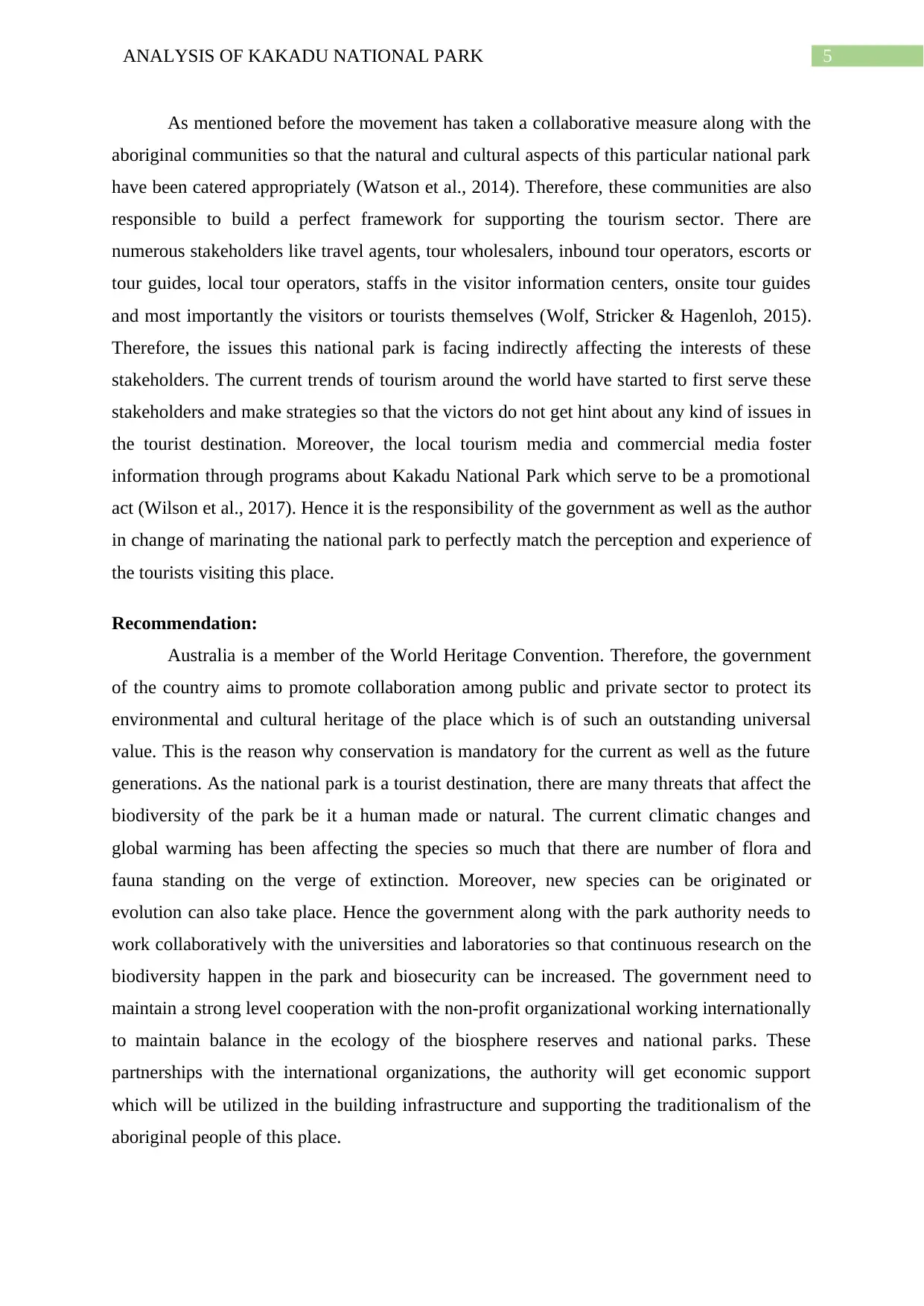
5ANALYSIS OF KAKADU NATIONAL PARK
As mentioned before the movement has taken a collaborative measure along with the
aboriginal communities so that the natural and cultural aspects of this particular national park
have been catered appropriately (Watson et al., 2014). Therefore, these communities are also
responsible to build a perfect framework for supporting the tourism sector. There are
numerous stakeholders like travel agents, tour wholesalers, inbound tour operators, escorts or
tour guides, local tour operators, staffs in the visitor information centers, onsite tour guides
and most importantly the visitors or tourists themselves (Wolf, Stricker & Hagenloh, 2015).
Therefore, the issues this national park is facing indirectly affecting the interests of these
stakeholders. The current trends of tourism around the world have started to first serve these
stakeholders and make strategies so that the victors do not get hint about any kind of issues in
the tourist destination. Moreover, the local tourism media and commercial media foster
information through programs about Kakadu National Park which serve to be a promotional
act (Wilson et al., 2017). Hence it is the responsibility of the government as well as the author
in change of marinating the national park to perfectly match the perception and experience of
the tourists visiting this place.
Recommendation:
Australia is a member of the World Heritage Convention. Therefore, the government
of the country aims to promote collaboration among public and private sector to protect its
environmental and cultural heritage of the place which is of such an outstanding universal
value. This is the reason why conservation is mandatory for the current as well as the future
generations. As the national park is a tourist destination, there are many threats that affect the
biodiversity of the park be it a human made or natural. The current climatic changes and
global warming has been affecting the species so much that there are number of flora and
fauna standing on the verge of extinction. Moreover, new species can be originated or
evolution can also take place. Hence the government along with the park authority needs to
work collaboratively with the universities and laboratories so that continuous research on the
biodiversity happen in the park and biosecurity can be increased. The government need to
maintain a strong level cooperation with the non-profit organizational working internationally
to maintain balance in the ecology of the biosphere reserves and national parks. These
partnerships with the international organizations, the authority will get economic support
which will be utilized in the building infrastructure and supporting the traditionalism of the
aboriginal people of this place.
As mentioned before the movement has taken a collaborative measure along with the
aboriginal communities so that the natural and cultural aspects of this particular national park
have been catered appropriately (Watson et al., 2014). Therefore, these communities are also
responsible to build a perfect framework for supporting the tourism sector. There are
numerous stakeholders like travel agents, tour wholesalers, inbound tour operators, escorts or
tour guides, local tour operators, staffs in the visitor information centers, onsite tour guides
and most importantly the visitors or tourists themselves (Wolf, Stricker & Hagenloh, 2015).
Therefore, the issues this national park is facing indirectly affecting the interests of these
stakeholders. The current trends of tourism around the world have started to first serve these
stakeholders and make strategies so that the victors do not get hint about any kind of issues in
the tourist destination. Moreover, the local tourism media and commercial media foster
information through programs about Kakadu National Park which serve to be a promotional
act (Wilson et al., 2017). Hence it is the responsibility of the government as well as the author
in change of marinating the national park to perfectly match the perception and experience of
the tourists visiting this place.
Recommendation:
Australia is a member of the World Heritage Convention. Therefore, the government
of the country aims to promote collaboration among public and private sector to protect its
environmental and cultural heritage of the place which is of such an outstanding universal
value. This is the reason why conservation is mandatory for the current as well as the future
generations. As the national park is a tourist destination, there are many threats that affect the
biodiversity of the park be it a human made or natural. The current climatic changes and
global warming has been affecting the species so much that there are number of flora and
fauna standing on the verge of extinction. Moreover, new species can be originated or
evolution can also take place. Hence the government along with the park authority needs to
work collaboratively with the universities and laboratories so that continuous research on the
biodiversity happen in the park and biosecurity can be increased. The government need to
maintain a strong level cooperation with the non-profit organizational working internationally
to maintain balance in the ecology of the biosphere reserves and national parks. These
partnerships with the international organizations, the authority will get economic support
which will be utilized in the building infrastructure and supporting the traditionalism of the
aboriginal people of this place.
⊘ This is a preview!⊘
Do you want full access?
Subscribe today to unlock all pages.

Trusted by 1+ million students worldwide
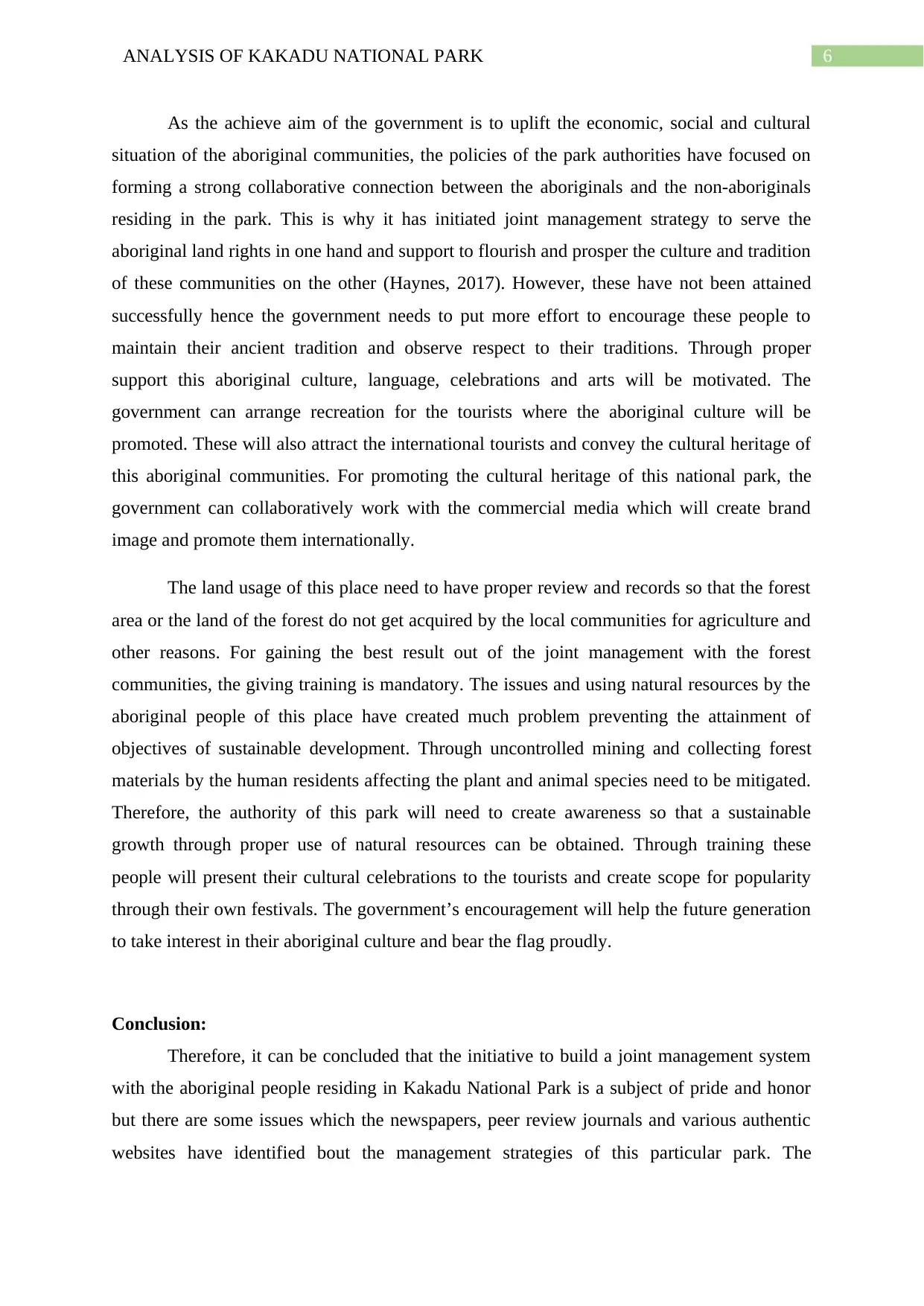
6ANALYSIS OF KAKADU NATIONAL PARK
As the achieve aim of the government is to uplift the economic, social and cultural
situation of the aboriginal communities, the policies of the park authorities have focused on
forming a strong collaborative connection between the aboriginals and the non-aboriginals
residing in the park. This is why it has initiated joint management strategy to serve the
aboriginal land rights in one hand and support to flourish and prosper the culture and tradition
of these communities on the other (Haynes, 2017). However, these have not been attained
successfully hence the government needs to put more effort to encourage these people to
maintain their ancient tradition and observe respect to their traditions. Through proper
support this aboriginal culture, language, celebrations and arts will be motivated. The
government can arrange recreation for the tourists where the aboriginal culture will be
promoted. These will also attract the international tourists and convey the cultural heritage of
this aboriginal communities. For promoting the cultural heritage of this national park, the
government can collaboratively work with the commercial media which will create brand
image and promote them internationally.
The land usage of this place need to have proper review and records so that the forest
area or the land of the forest do not get acquired by the local communities for agriculture and
other reasons. For gaining the best result out of the joint management with the forest
communities, the giving training is mandatory. The issues and using natural resources by the
aboriginal people of this place have created much problem preventing the attainment of
objectives of sustainable development. Through uncontrolled mining and collecting forest
materials by the human residents affecting the plant and animal species need to be mitigated.
Therefore, the authority of this park will need to create awareness so that a sustainable
growth through proper use of natural resources can be obtained. Through training these
people will present their cultural celebrations to the tourists and create scope for popularity
through their own festivals. The government’s encouragement will help the future generation
to take interest in their aboriginal culture and bear the flag proudly.
Conclusion:
Therefore, it can be concluded that the initiative to build a joint management system
with the aboriginal people residing in Kakadu National Park is a subject of pride and honor
but there are some issues which the newspapers, peer review journals and various authentic
websites have identified bout the management strategies of this particular park. The
As the achieve aim of the government is to uplift the economic, social and cultural
situation of the aboriginal communities, the policies of the park authorities have focused on
forming a strong collaborative connection between the aboriginals and the non-aboriginals
residing in the park. This is why it has initiated joint management strategy to serve the
aboriginal land rights in one hand and support to flourish and prosper the culture and tradition
of these communities on the other (Haynes, 2017). However, these have not been attained
successfully hence the government needs to put more effort to encourage these people to
maintain their ancient tradition and observe respect to their traditions. Through proper
support this aboriginal culture, language, celebrations and arts will be motivated. The
government can arrange recreation for the tourists where the aboriginal culture will be
promoted. These will also attract the international tourists and convey the cultural heritage of
this aboriginal communities. For promoting the cultural heritage of this national park, the
government can collaboratively work with the commercial media which will create brand
image and promote them internationally.
The land usage of this place need to have proper review and records so that the forest
area or the land of the forest do not get acquired by the local communities for agriculture and
other reasons. For gaining the best result out of the joint management with the forest
communities, the giving training is mandatory. The issues and using natural resources by the
aboriginal people of this place have created much problem preventing the attainment of
objectives of sustainable development. Through uncontrolled mining and collecting forest
materials by the human residents affecting the plant and animal species need to be mitigated.
Therefore, the authority of this park will need to create awareness so that a sustainable
growth through proper use of natural resources can be obtained. Through training these
people will present their cultural celebrations to the tourists and create scope for popularity
through their own festivals. The government’s encouragement will help the future generation
to take interest in their aboriginal culture and bear the flag proudly.
Conclusion:
Therefore, it can be concluded that the initiative to build a joint management system
with the aboriginal people residing in Kakadu National Park is a subject of pride and honor
but there are some issues which the newspapers, peer review journals and various authentic
websites have identified bout the management strategies of this particular park. The
Paraphrase This Document
Need a fresh take? Get an instant paraphrase of this document with our AI Paraphraser

7ANALYSIS OF KAKADU NATIONAL PARK
sustainable principles are getting hampered by numerous reasons which is changing the
biodiversity as well as the cultural heritage of this place. At this point the authority needs to
take initiates to research and report these issues and make decisions to minimize the affect
both for the natural environment of the place as well as the tourism sector of Kakadu National
Park.
sustainable principles are getting hampered by numerous reasons which is changing the
biodiversity as well as the cultural heritage of this place. At this point the authority needs to
take initiates to research and report these issues and make decisions to minimize the affect
both for the natural environment of the place as well as the tourism sector of Kakadu National
Park.
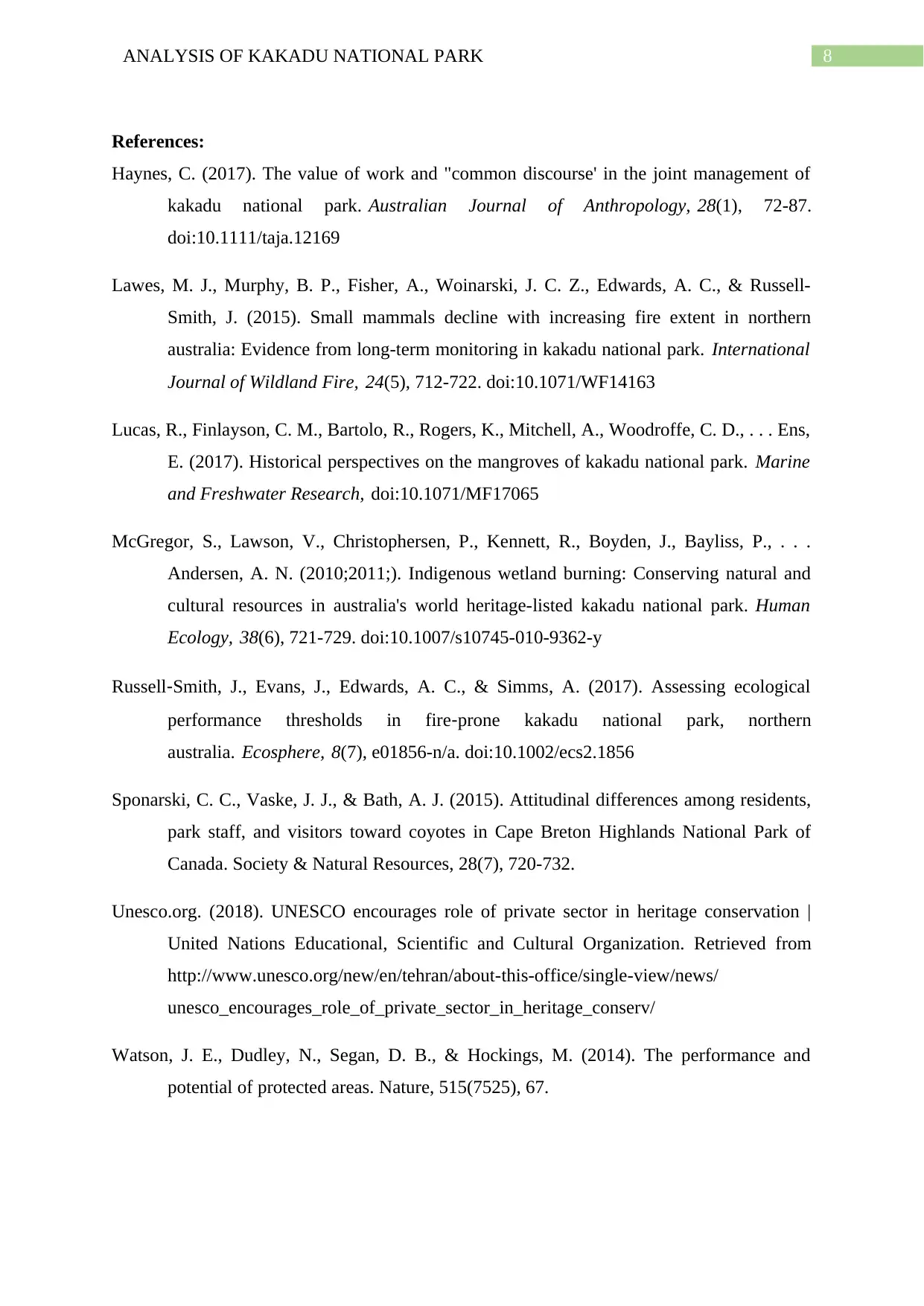
8ANALYSIS OF KAKADU NATIONAL PARK
References:
Haynes, C. (2017). The value of work and "common discourse' in the joint management of
kakadu national park. Australian Journal of Anthropology, 28(1), 72-87.
doi:10.1111/taja.12169
Lawes, M. J., Murphy, B. P., Fisher, A., Woinarski, J. C. Z., Edwards, A. C., & Russell-
Smith, J. (2015). Small mammals decline with increasing fire extent in northern
australia: Evidence from long-term monitoring in kakadu national park. International
Journal of Wildland Fire, 24(5), 712-722. doi:10.1071/WF14163
Lucas, R., Finlayson, C. M., Bartolo, R., Rogers, K., Mitchell, A., Woodroffe, C. D., . . . Ens,
E. (2017). Historical perspectives on the mangroves of kakadu national park. Marine
and Freshwater Research, doi:10.1071/MF17065
McGregor, S., Lawson, V., Christophersen, P., Kennett, R., Boyden, J., Bayliss, P., . . .
Andersen, A. N. (2010;2011;). Indigenous wetland burning: Conserving natural and
cultural resources in australia's world heritage-listed kakadu national park. Human
Ecology, 38(6), 721-729. doi:10.1007/s10745-010-9362-y
Russell‐Smith, J., Evans, J., Edwards, A. C., & Simms, A. (2017). Assessing ecological
performance thresholds in fire‐prone kakadu national park, northern
australia. Ecosphere, 8(7), e01856-n/a. doi:10.1002/ecs2.1856
Sponarski, C. C., Vaske, J. J., & Bath, A. J. (2015). Attitudinal differences among residents,
park staff, and visitors toward coyotes in Cape Breton Highlands National Park of
Canada. Society & Natural Resources, 28(7), 720-732.
Unesco.org. (2018). UNESCO encourages role of private sector in heritage conservation |
United Nations Educational, Scientific and Cultural Organization. Retrieved from
http://www.unesco.org/new/en/tehran/about-this-office/single-view/news/
unesco_encourages_role_of_private_sector_in_heritage_conserv/
Watson, J. E., Dudley, N., Segan, D. B., & Hockings, M. (2014). The performance and
potential of protected areas. Nature, 515(7525), 67.
References:
Haynes, C. (2017). The value of work and "common discourse' in the joint management of
kakadu national park. Australian Journal of Anthropology, 28(1), 72-87.
doi:10.1111/taja.12169
Lawes, M. J., Murphy, B. P., Fisher, A., Woinarski, J. C. Z., Edwards, A. C., & Russell-
Smith, J. (2015). Small mammals decline with increasing fire extent in northern
australia: Evidence from long-term monitoring in kakadu national park. International
Journal of Wildland Fire, 24(5), 712-722. doi:10.1071/WF14163
Lucas, R., Finlayson, C. M., Bartolo, R., Rogers, K., Mitchell, A., Woodroffe, C. D., . . . Ens,
E. (2017). Historical perspectives on the mangroves of kakadu national park. Marine
and Freshwater Research, doi:10.1071/MF17065
McGregor, S., Lawson, V., Christophersen, P., Kennett, R., Boyden, J., Bayliss, P., . . .
Andersen, A. N. (2010;2011;). Indigenous wetland burning: Conserving natural and
cultural resources in australia's world heritage-listed kakadu national park. Human
Ecology, 38(6), 721-729. doi:10.1007/s10745-010-9362-y
Russell‐Smith, J., Evans, J., Edwards, A. C., & Simms, A. (2017). Assessing ecological
performance thresholds in fire‐prone kakadu national park, northern
australia. Ecosphere, 8(7), e01856-n/a. doi:10.1002/ecs2.1856
Sponarski, C. C., Vaske, J. J., & Bath, A. J. (2015). Attitudinal differences among residents,
park staff, and visitors toward coyotes in Cape Breton Highlands National Park of
Canada. Society & Natural Resources, 28(7), 720-732.
Unesco.org. (2018). UNESCO encourages role of private sector in heritage conservation |
United Nations Educational, Scientific and Cultural Organization. Retrieved from
http://www.unesco.org/new/en/tehran/about-this-office/single-view/news/
unesco_encourages_role_of_private_sector_in_heritage_conserv/
Watson, J. E., Dudley, N., Segan, D. B., & Hockings, M. (2014). The performance and
potential of protected areas. Nature, 515(7525), 67.
⊘ This is a preview!⊘
Do you want full access?
Subscribe today to unlock all pages.

Trusted by 1+ million students worldwide
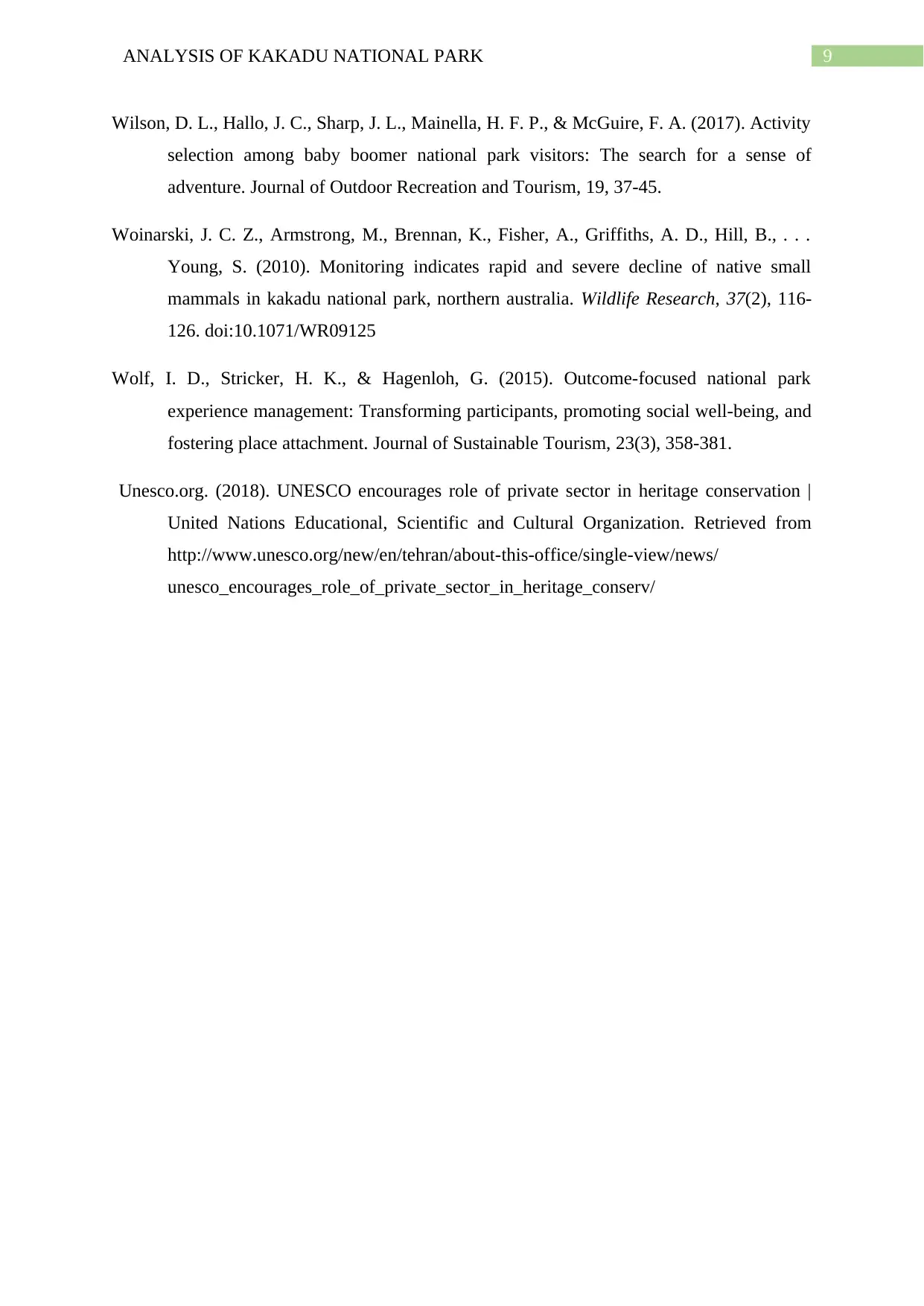
9ANALYSIS OF KAKADU NATIONAL PARK
Wilson, D. L., Hallo, J. C., Sharp, J. L., Mainella, H. F. P., & McGuire, F. A. (2017). Activity
selection among baby boomer national park visitors: The search for a sense of
adventure. Journal of Outdoor Recreation and Tourism, 19, 37-45.
Woinarski, J. C. Z., Armstrong, M., Brennan, K., Fisher, A., Griffiths, A. D., Hill, B., . . .
Young, S. (2010). Monitoring indicates rapid and severe decline of native small
mammals in kakadu national park, northern australia. Wildlife Research, 37(2), 116-
126. doi:10.1071/WR09125
Wolf, I. D., Stricker, H. K., & Hagenloh, G. (2015). Outcome-focused national park
experience management: Transforming participants, promoting social well-being, and
fostering place attachment. Journal of Sustainable Tourism, 23(3), 358-381.
Unesco.org. (2018). UNESCO encourages role of private sector in heritage conservation |
United Nations Educational, Scientific and Cultural Organization. Retrieved from
http://www.unesco.org/new/en/tehran/about-this-office/single-view/news/
unesco_encourages_role_of_private_sector_in_heritage_conserv/
Wilson, D. L., Hallo, J. C., Sharp, J. L., Mainella, H. F. P., & McGuire, F. A. (2017). Activity
selection among baby boomer national park visitors: The search for a sense of
adventure. Journal of Outdoor Recreation and Tourism, 19, 37-45.
Woinarski, J. C. Z., Armstrong, M., Brennan, K., Fisher, A., Griffiths, A. D., Hill, B., . . .
Young, S. (2010). Monitoring indicates rapid and severe decline of native small
mammals in kakadu national park, northern australia. Wildlife Research, 37(2), 116-
126. doi:10.1071/WR09125
Wolf, I. D., Stricker, H. K., & Hagenloh, G. (2015). Outcome-focused national park
experience management: Transforming participants, promoting social well-being, and
fostering place attachment. Journal of Sustainable Tourism, 23(3), 358-381.
Unesco.org. (2018). UNESCO encourages role of private sector in heritage conservation |
United Nations Educational, Scientific and Cultural Organization. Retrieved from
http://www.unesco.org/new/en/tehran/about-this-office/single-view/news/
unesco_encourages_role_of_private_sector_in_heritage_conserv/
1 out of 10
Related Documents
Your All-in-One AI-Powered Toolkit for Academic Success.
+13062052269
info@desklib.com
Available 24*7 on WhatsApp / Email
![[object Object]](/_next/static/media/star-bottom.7253800d.svg)
Unlock your academic potential
Copyright © 2020–2025 A2Z Services. All Rights Reserved. Developed and managed by ZUCOL.



